Friday, March 31, 2006
Thursday, March 30, 2006
right on the world united, click
The Associated Press - Secretary of State Condoleezza Rice warned Iran on Thursday the "international community is united" in the dispute over its nuclear program, but a Tehran envoy defiantly rejected a U.N. call to reimpose a freeze on uranium enrichment. click on header to read the news or SCROLL DOWN to read my new posting.
Here is the bruise on my arm after they drew blood
Well I never had it this bad, its a huge spot and hurts a bit. I got my blood test's results today and my cholestrol is higher than last year, and my tri-glycerin too. have to loose 15 pounds (God I cant even loose 2 pounds) and also exercize . Well the new pills did not agree with me and I had to stop tehm and take them one by one... I wish there was somebody like kojast madar kojast gahvareye man....
here is another pic of my kaboodi as we say ookh shode boosesh konam like mother's always used to say it, I remember my father once read me a poem and in there said thousands nurses and doctors cant cure you better than a kiss from a mother on a child's wound.m
here is another pic of my kaboodi as we say ookh shode boosesh konam like mother's always used to say it, I remember my father once read me a poem and in there said thousands nurses and doctors cant cure you better than a kiss from a mother on a child's wound.m
Wednesday, March 29, 2006
Tuesday, March 28, 2006
Monday, March 27, 2006
Dare to do this in front of your Persian Parents...

once a month is more than enough to see a certain person or talk to... I went to this Dr.and said I am depressed and he said take these pills and when I returned I heard he is called to middle east ...;-) world is so strange everything happens for a reason... now click here and see a belly dancer better than Khordadian.

Sunday, March 26, 2006
Friday, March 24, 2006
Thursday, March 23, 2006
why not
well; when I was young I was selfish and I should let others be selfish now. I am depressed now and cant wait for summer to go swimming and mybe feel better. I dont know how long more I have to wait before I can find a full time job. I know people that after couple of months of no income and insurance go crazy and I have been in this situation for years... I feel like breaking and here I say if I do whatever I have goes to my son. Well lets hope that I feel better cause I am fed up with the situation in Iran and in my life with no health insurance also. I have education and willing and able to work ; but why not?
Wednesday, March 22, 2006
Tuesday, March 21, 2006
swear to God these are not my feet,but from flickr

gojehe sabze torshe namak zadehe zire pa leh shode.... do you remember swimming and lying down under the sun? aghelan danando fahmand.. ok these are my feet. now click on header and do some garage saling...

Monday, March 20, 2006
joon I saw my son for new year....

thank God his car worked and I even had a ride inhis porsche... horray,sali keh nekoost as baharash peydast.. eide hame mobarak and listent o this nice card I got from my neice and scroll down to see and hear the music. click here. rasti shoma chandom mishinin biayam eid didani?

Saturday, March 18, 2006
NOROOZ BA BANAFSHEH MIAYAD
swear to God click here o listen to thank you baby and wait a while pleaase.I got it. Click here to watch 'thankyoubabay' GOT FLOWERS, MIRROR,COOKIES,... CANT IGNORE NOROOZ THOU SAD STUFF HAPPENED AT SOME NOROOZ BUT STILL SPRING CONQUERS ALL...NOW SCROLL DOWN OR CLICK ON HEADER.
HAFT SEEN IN PROGRESS SCROLL DOWN
ADDED QURAN, MAMAN'S BOOK(GRAND MA) AND MOTHER'S PICTURE AND MOSSADEGH'S PICTURE FOR TODAY CAUSE IS ANNIVERSARY OF NATIONALIZATION OF OIL IN iRAN. PLEASE SCROLL DOWN TO READ THE ARTICLE. WILL POST MORE PICS IF MORE ITEMS ARE ADDED TO THE HAFT SEEN!WHAT IS HAFT SEEN>? SCROLL DOWN...
God give strength to his car for our New year, Amen
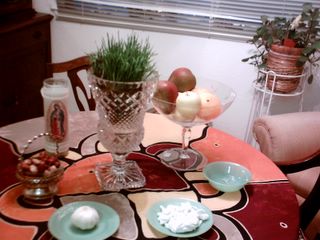
this is my haft seen before fresh flowers and Quran, will finish tomorrow. I am going to put my grand ma's ketab daa on the table. My son maybe in LA with me if his car run o.k. This is 7 S's for health,youth, fertility and sweetness. read about it under topic of nourooz,new day. first day of spring is first day of our new year,meaning monday 10 am. Eide Nourooz Mobarak. there are senjed,somagh,sir,sekeh in noghl,serkeh,sabze and sib and sofreh as zapas! only if my son were here then my haft sin was takmil,perfect with all of his goodness and charm...kisses and kisses..btw ALL ITEMS ON THAT TABLE ARE FOR SALE AT WWW.ROYAARTGALLERY.BLOGSPOT.COM! CLICK ON HEADER TO GO THERE IF YOU WANT..

Friday, March 17, 2006
click here to listen to thank you baby
thanks to whoever fixed my blog. thanks to Bita got the address,You_veMadeMeSoVeryHappy-Blood,Sweat,andTears.mp3 it is a BIG file takes a while to download be patient. THANKS TO THIS SITE http://www.ladysunshinesworld.com.so send me an email and I send you the music that is all I can do now till somebody teach me how to attach it here. my email is royaparsay@msn.com ,send me an email and ask for the song, I email it back to you. thank you babe....
Tuesday, March 14, 2006
LOVE AND 4SHANBEH SOURI

Love: 10 crazy scientific facts
By Laura Schaefer
1. It�s like looking in a mirror! It turns out we all have a little something in common with Narcissus�the mythical fellow who fell in love with his own reflection. Scientists at the University of Liverpool recently concluded that our brains favor people with familiar faces. The research team asked over 200 participants to view a number of digitally altered human faces. They found that subjects preferred the features they found the most familiar�whether that means his or her own visage or that of a family member. This may explain that common phenomenon of couples looking like they could be siblings.
2. Manner, schmanners: Go ahead and stare. Another new study says that when a woman walks into a room, she is considered more attractive if she turns her eyes directly toward a certain man. Men would rate the same woman as less desirable if she doesn�t make strong eye contact. In this study, conducted at Dartmouth University, lead researcher Malia Mason had male participants sit and view a series of faces of fashion models, digitally enhanced to either be gazing toward or away from the participant. The study authors asked the viewer to rate the likeability of each model and found that those who turned away were seen as less agreeable. The study�s researchers went on to suggest that a woman�s gaze can be a powerful arousal cue and that our impressions are largely formed by nonverbal communications such as eye contact. So start locking eyes, ladies!
3. You�ll know it when you see it. A recent study at the University of Pennsylvania reveals that regardless of what people say they are looking for in a dating situation, they don�t need a lot of time with or information about a person to tell if they�re interested. Single people�s behavior suggests that individuals know �it� (a person who appeals to them) when they see it�almost instantly. Lead researcher Robert Kurzban and his colleagues studied data from 10,000+ daters. They found that men and women assessed potential compatibility within moments of meeting, using primarily visual cues such as age, height, and attractiveness. Says Kurzban, �Somewhat surprisingly, factors that you might think would be really important to people � like religion, education, and income � played very little roles in their choices.�
4. Listen up. The next time you call up a potential love match, pay special attention to how they sound. Researchers at the University of Albany had 149 men and women rate the attractiveness of a series of recorded voices on a scale from 1 to 10. The researchers also gathered information about the sexual histories of the people whose voices they recorded. They found that the voices found to be the most appealing belonged to people who had sex at an earlier age, had more sexual partners, and were more prone to infidelity than those rated as having less appealing voices. So know that what�s a seductive voice to you may be linked to a person with a bit of a past�
5. I couldn�t help it baby, it�s in my genes. There may be a genetic component to infidelity, says a professor at the Twin Research Unit at St. Thomas� Hospital, London. This is based on the fact that if one twin exhibits infidelity, the other twin strays 55% of the time. In the general population, the number is 23%. The tendency to remain faithful is a component of personality, the scientist elaborates, which is governed both by a number of genes and societal factors.
6. It�s official. Love makes us crazy. For one, it causes serotonin levels in the brain to drop, which may lead people to obsess about their lover. (The levels of serotonin, a chemical produced by the body, are also low in people who have obsessive-compulsive disorder.) Next, it ramps up production of the stress hormone cortisol, leading to slightly higher blood pressure and possible loss of sleep. Finally, a scientist at the University of London has found that when people look at their new loves, the neural circuits that are usually in charge of social judgment are suppressed. All in all, love kind of leaves you obsessive, stressed, and blind. And we love it.
7. Why broken hearts hurt... A recent UCLA study suggests the psychological hurt of a break-up is just as real as a physical injury. Two areas of the brain that respond to physical pain also become activated when a person is dealing with social pain, such as being dumped. The study�s authors used an MRI to monitor brain activity in participants while they played a game simulating social rejection. The researchers believe that the pain of being rejected may have evolved as a motivating force that led humans to seek out social interaction, which is crucial for the survival of most mammals.
8. Blushing is best. If we take our cue from apes, rosy cheeks are crucial in the dating game, says a new study. Scientists at Stirling University in Great Britain have found that primates prefer mates with red faces. A rosy glow might also act as a similar cue in humans, say the British researchers, sending a message of good health. They speculate that it could explain why women use blusher.
9. Kiss this way. Did you know there is a �right� way to kiss? People are more likely to tilt their heads to the right when kissing instead of left, says a report published recently in the journal Nature. A scientist from Ruhr University in Germany analyzed 124 pairs of smoochers and found that 65 percent go toward the right.
10. Meet for drinks before dinner. Researchers at NYU and Stanford have discovered that hungry men prefer heavier women. By staking out a dining hall, scientists had hundreds of students fill out questionnaires about their preferences in a mate. Men who filled out the questionnaire just before they entered the hall described their ideal woman as an average of three or four pounds heavier than men interviewed after they ate. Incidentally, researchers did not find the same change in women�s preferences, so guys: Go ahead and schedule that drinks date for before or after dinnertime.

Monday, March 13, 2006
click here for charshanbehsouri
As you read the article when you scroll dodwn; you find out how many facts are hidden from the world when the credit is due to a Muslim or an Arab, and how Racist the world has become in that nature. I was also trying to find information about an American inventor who is African-American Geoffrey ,invented design of motor and found no information about him. Another black guy inventing cell phone has no picture and info. either, shame on the world after Hitler , other acts like Hitler as racist are going on. well please scroll down to read the article from The Independent.
HOW ISLAMIC INVENTORS CHANGED THE WORLD,CLICK

How Islamic inventors changed the world, AN ARTICLE IN INDEPENDENT ,CLCIK ON HEADRE TO SEE OR READ ON. THANKS DEAR FOR SENDING ME, NOW IF SOMEBODY SEND ME THE ADDRESS FOR THANK YOU BABE OF CHICAGO i CAN PLAY IT HERE..
From coffee to cheques and the three-course meal, the Muslim world has given us many innovations that we take for granted in daily life. As a new exhibition opens, Paul Vallely nominates 20 of the most influential- and identifies the men of genius behind them
Published: 11 March 2006
1 The story goes that an Arab named Khalid was tending his goats in the Kaffa region of southern Ethiopia, when he noticed his animals became livelier after eating a certain berry. He boiled the berries to make the first coffee. Certainly the first record of the drink is of beans exported from Ethiopia to Yemen where Sufis drank it to stay awake all night to pray on special occasions. By the late 15th century it had arrived in Mecca and Turkey from where it made its way to Venice in 1645. It was brought to England in 1650 by a Turk named Pasqua Rosee who opened the first coffee house in Lombard Street in the City of London. The Arabic qahwa became the Turkish kahve then the Italian caff� and then English coffee.
2 The ancient Greeks thought our eyes emitted rays, like a laser, which enabled us to see. The first person to realise that light enters the eye, rather than leaving it, was the 10th-century Muslim mathematician, astronomer and physicist Ibn al-Haitham. He invented the first pin-hole camera after noticing the way light came through a hole in window shutters. The smaller the hole, the better the picture, he worked out, and set up the first Camera Obscura (from the Arab word qamara for a dark or private room). He is also credited with being the first man to shift physics from a philosophical activity to an experimental one.
3 A form of chess was played in ancient India but the game was developed into the form we know it today in Persia. From there it spread westward to Europe - where it was introduced by the Moors in Spain in the 10th century - and eastward as far as Japan. The word rook comes from the Persian rukh, which means chariot.
4 A thousand years before the Wright brothers a Muslim poet, astronomer, musician and engineer named Abbas ibn Firnas made several attempts to construct a flying machine. In 852 he jumped from the minaret of the Grand Mosque in Cordoba using a loose cloak stiffened with wooden struts. He hoped to glide like a bird. He didn't. But the cloak slowed his fall, creating what is thought to be the first parachute, and leaving him with only minor injuries. In 875, aged 70, having perfected a machine of silk and eagles' feathers he tried again, jumping from a mountain. He flew to a significant height and stayed aloft for ten minutes but crashed on landing - concluding, correctly, that it was because he had not given his device a tail so it would stall on landing. Baghdad international airport and a crater on the Moon are named after him.
5 Washing and bathing are religious requirements for Muslims, which is perhaps why they perfected the recipe for soap which we still use today. The ancient Egyptians had soap of a kind, as did the Romans who used it more as a pomade. But it was the Arabs who combined vegetable oils with sodium hydroxide and aromatics such as thyme oil. One of the Crusaders' most striking characteristics, to Arab nostrils, was that they did not wash. Shampoo was introduced to England by a Muslim who opened Mahomed's Indian Vapour Baths on Brighton seafront in 1759 and was appointed Shampooing Surgeon to Kings George IV and William IV.
6 Distillation, the means of separating liquids through differences in their boiling points, was invented around the year 800 by Islam's foremost scientist, Jabir ibn Hayyan, who transformed alchemy into chemistry, inventing many of the basic processes and apparatus still in use today - liquefaction, crystallisation, distillation, purification, oxidisation, evaporation and filtration. As well as discovering sulphuric and nitric acid, he invented the alembic still, giving the world intense rosewater and other perfumes and alcoholic spirits (although drinking them is haram, or forbidden, in Islam). Ibn Hayyan emphasised systematic experimentation and was the founder of modern chemistry.
7 The crank-shaft is a device which translates rotary into linear motion and is central to much of the machinery in the modern world, not least the internal combustion engine. One of the most important mechanical inventions in the history of humankind, it was created by an ingenious Muslim engineer called al-Jazari to raise water for irrigation. His 1206 Book of Knowledge of Ingenious Mechanical Devices shows he also invented or refined the use of valves and pistons, devised some of the first mechanical clocks driven by water and weights, and was the father of robotics. Among his 50 other inventions was the combination lock.
8 Quilting is a method of sewing or tying two layers of cloth with a layer of insulating material in between. It is not clear whether it was invented in the Muslim world or whether it was imported there from India or China. But it certainly came to the West via the Crusaders. They saw it used by Saracen warriors, who wore straw-filled quilted canvas shirts instead of armour. As well as a form of protection, it proved an effective guard against the chafing of the Crusaders' metal armour and was an effective form of insulation - so much so that it became a cottage industry back home in colder climates such as Britain and Holland.
9 The pointed arch so characteristic of Europe's Gothic cathedrals was an invention borrowed from Islamic architecture. It was much stronger than the rounded arch used by the Romans and Normans, thus allowing the building of bigger, higher, more complex and grander buildings. Other borrowings from Muslim genius included ribbed vaulting, rose windows and dome-building techniques. Europe's castles were also adapted to copy the Islamic world's - with arrow slits, battlements, a barbican and parapets. Square towers and keeps gave way to more easily defended round ones. Henry V's castle architect was a Muslim.
10 Many modern surgical instruments are of exactly the same design as those devised in the 10th century by a Muslim surgeon called al-Zahrawi. His scalpels, bone saws, forceps, fine scissors for eye surgery and many of the 200 instruments he devised are recognisable to a modern surgeon. It was he who discovered that catgut used for internal stitches dissolves away naturally (a discovery he made when his monkey ate his lute strings) and that it can be also used to make medicine capsules. In the 13th century, another Muslim medic named Ibn Nafis described the circulation of the blood, 300 years before William Harvey discovered it. Muslims doctors also invented anaesthetics of opium and alcohol mixes and developed hollow needles to suck cataracts from eyes in a technique still used today.
11 The windmill was invented in 634 for a Persian caliph and was used to grind corn and draw up water for irrigation. In the vast deserts of Arabia, when the seasonal streams ran dry, the only source of power was the wind which blew steadily from one direction for months. Mills had six or 12 sails covered in fabric or palm leaves. It was 500 years before the first windmill was seen in Europe.
12 The technique of inoculation was not invented by Jenner and Pasteur but was devised in the Muslim world and brought to Europe from Turkey by the wife of the English ambassador to Istanbul in 1724. Children in Turkey were vaccinated with cowpox to fight the deadly smallpox at least 50 years before the West discovered it.
13 The fountain pen was invented for the Sultan of Egypt in 953 after he demanded a pen which would not stain his hands or clothes. It held ink in a reservoir and, as with modern pens, fed ink to the nib by a combination of gravity and capillary action.
14 The system of numbering in use all round the world is probably Indian in origin but the style of the numerals is Arabic and first appears in print in the work of the Muslim mathematicians al-Khwarizmi and al-Kindi around 825. Algebra was named after al-Khwarizmi's book, Al-Jabr wa-al-Muqabilah, much of whose contents are still in use. The work of Muslim maths scholars was imported into Europe 300 years later by the Italian mathematician Fibonacci. Algorithms and much of the theory of trigonometry came from the Muslim world. And Al-Kindi's discovery of frequency analysis rendered all the codes of the ancient world soluble and created the basis of modern cryptology.
15 Ali ibn Nafi, known by his nickname of Ziryab (Blackbird) came from Iraq to Cordoba in the 9th century and brought with him the concept of the three-course meal - soup, followed by fish or meat, then fruit and nuts. He also introduced crystal glasses (which had been invented after experiments with rock crystal by Abbas ibn Firnas - see No 4).
16 Carpets were regarded as part of Paradise by medieval Muslims, thanks to their advanced weaving techniques, new tinctures from Islamic chemistry and highly developed sense of pattern and arabesque which were the basis of Islam's non-representational art. In contrast, Europe's floors were distinctly earthly, not to say earthy, until Arabian and Persian carpets were introduced. In England, as Erasmus recorded, floors were "covered in rushes, occasionally renewed, but so imperfectly that the bottom layer is left undisturbed, sometimes for 20 years, harbouring expectoration, vomiting, the leakage of dogs and men, ale droppings, scraps of fish, and other abominations not fit to be mentioned". Carpets, unsurprisingly, caught on quickly.
17 The modern cheque comes from the Arabic saqq, a written vow to pay for goods when they were delivered, to avoid money having to be transported across dangerous terrain. In the 9th century, a Muslim businessman could cash a cheque in China drawn on his bank in Baghdad.
18 By the 9th century, many Muslim scholars took it for granted that the Earth was a sphere. The proof, said astronomer Ibn Hazm, "is that the Sun is always vertical to a particular spot on Earth". It was 500 years before that realisation dawned on Galileo. The calculations of Muslim astronomers were so accurate that in the 9th century they reckoned the Earth's circumference to be 40,253.4km - less than 200km out. The scholar al-Idrisi took a globe depicting the world to the court of King Roger of Sicily in 1139.
19 Though the Chinese invented saltpetre gunpowder, and used it in their fireworks, it was the Arabs who worked out that it could be purified using potassium nitrate for military use. Muslim incendiary devices terrified the Crusaders. By the 15th century they had invented both a rocket, which they called a "self-moving and combusting egg", and a torpedo - a self-propelled pear-shaped bomb with a spear at the front which impaled itself in enemy ships and then blew up.
20 Medieval Europe had kitchen and herb gardens, but it was the Arabs who developed the idea of the garden as a place of beauty and meditation. The first royal pleasure gardens in Europe were opened in 11th-century Muslim Spain. Flowers which originated in Muslim gardens include the carnation and the tulip.
"1001 Inventions: Discover the Muslim Heritage in Our World" is a new exhibition which began a nationwide tour this week. It is currently at the Science Museum in Manchester. For more information, go to www.1001inventions.com
1 The story goes that an Arab named Khalid was tending his goats in the Kaffa region of southern Ethiopia, when he noticed his animals became livelier after eating a certain berry. He boiled the berries to make the first coffee. Certainly the first record of the drink is of beans exported from Ethiopia to Yemen where Sufis drank it to stay awake all night to pray on special occasions. By the late 15th century it had arrived in Mecca and Turkey from where it made its way to Venice in 1645. It was brought to England in 1650 by a Turk named Pasqua Rosee who opened the first coffee house in Lombard Street in the City of London. The Arabic qahwa became the Turkish kahve then the Italian caff� and then English coffee.
2 The ancient Greeks thought our eyes emitted rays, like a laser, which enabled us to see. The first person to realise that light enters the eye, rather than leaving it, was the 10th-century Muslim mathematician, astronomer and physicist Ibn al-Haitham. He invented the first pin-hole camera after noticing the way light came through a hole in window shutters. The smaller the hole, the better the picture, he worked out, and set up the first Camera Obscura (from the Arab word qamara for a dark or private room). He is also credited with being the first man to shift physics from a philosophical activity to an experimental one.
3 A form of chess was played in ancient India but the game was developed into the form we know it today in Persia. From there it spread westward to Europe - where it was introduced by the Moors in Spain in the 10th century - and eastward as far as Japan. The word rook comes from the Persian rukh, which means chariot.
4 A thousand years before the Wright brothers a Muslim poet, astronomer, musician and engineer named Abbas ibn Firnas made several attempts to construct a flying machine. In 852 he jumped from the minaret of the Grand Mosque in Cordoba using a loose cloak stiffened with wooden struts. He hoped to glide like a bird. He didn't. But the cloak slowed his fall, creating what is thought to be the first parachute, and leaving him with only minor injuries. In 875, aged 70, having perfected a machine of silk and eagles' feathers he tried again, jumping from a mountain. He flew to a significant height and stayed aloft for ten minutes but crashed on landing - concluding, correctly, that it was because he had not given his device a tail so it would stall on landing. Baghdad international airport and a crater on the Moon are named after him.
5 Washing and bathing are religious requirements for Muslims, which is perhaps why they perfected the recipe for soap which we still use today. The ancient Egyptians had soap of a kind, as did the Romans who used it more as a pomade. But it was the Arabs who combined vegetable oils with sodium hydroxide and aromatics such as thyme oil. One of the Crusaders' most striking characteristics, to Arab nostrils, was that they did not wash. Shampoo was introduced to England by a Muslim who opened Mahomed's Indian Vapour Baths on Brighton seafront in 1759 and was appointed Shampooing Surgeon to Kings George IV and William IV.
6 Distillation, the means of separating liquids through differences in their boiling points, was invented around the year 800 by Islam's foremost scientist, Jabir ibn Hayyan, who transformed alchemy into chemistry, inventing many of the basic processes and apparatus still in use today - liquefaction, crystallisation, distillation, purification, oxidisation, evaporation and filtration. As well as discovering sulphuric and nitric acid, he invented the alembic still, giving the world intense rosewater and other perfumes and alcoholic spirits (although drinking them is haram, or forbidden, in Islam). Ibn Hayyan emphasised systematic experimentation and was the founder of modern chemistry.
7 The crank-shaft is a device which translates rotary into linear motion and is central to much of the machinery in the modern world, not least the internal combustion engine. One of the most important mechanical inventions in the history of humankind, it was created by an ingenious Muslim engineer called al-Jazari to raise water for irrigation. His 1206 Book of Knowledge of Ingenious Mechanical Devices shows he also invented or refined the use of valves and pistons, devised some of the first mechanical clocks driven by water and weights, and was the father of robotics. Among his 50 other inventions was the combination lock.
8 Quilting is a method of sewing or tying two layers of cloth with a layer of insulating material in between. It is not clear whether it was invented in the Muslim world or whether it was imported there from India or China. But it certainly came to the West via the Crusaders. They saw it used by Saracen warriors, who wore straw-filled quilted canvas shirts instead of armour. As well as a form of protection, it proved an effective guard against the chafing of the Crusaders' metal armour and was an effective form of insulation - so much so that it became a cottage industry back home in colder climates such as Britain and Holland.
9 The pointed arch so characteristic of Europe's Gothic cathedrals was an invention borrowed from Islamic architecture. It was much stronger than the rounded arch used by the Romans and Normans, thus allowing the building of bigger, higher, more complex and grander buildings. Other borrowings from Muslim genius included ribbed vaulting, rose windows and dome-building techniques. Europe's castles were also adapted to copy the Islamic world's - with arrow slits, battlements, a barbican and parapets. Square towers and keeps gave way to more easily defended round ones. Henry V's castle architect was a Muslim.
10 Many modern surgical instruments are of exactly the same design as those devised in the 10th century by a Muslim surgeon called al-Zahrawi. His scalpels, bone saws, forceps, fine scissors for eye surgery and many of the 200 instruments he devised are recognisable to a modern surgeon. It was he who discovered that catgut used for internal stitches dissolves away naturally (a discovery he made when his monkey ate his lute strings) and that it can be also used to make medicine capsules. In the 13th century, another Muslim medic named Ibn Nafis described the circulation of the blood, 300 years before William Harvey discovered it. Muslims doctors also invented anaesthetics of opium and alcohol mixes and developed hollow needles to suck cataracts from eyes in a technique still used today.
11 The windmill was invented in 634 for a Persian caliph and was used to grind corn and draw up water for irrigation. In the vast deserts of Arabia, when the seasonal streams ran dry, the only source of power was the wind which blew steadily from one direction for months. Mills had six or 12 sails covered in fabric or palm leaves. It was 500 years before the first windmill was seen in Europe.
12 The technique of inoculation was not invented by Jenner and Pasteur but was devised in the Muslim world and brought to Europe from Turkey by the wife of the English ambassador to Istanbul in 1724. Children in Turkey were vaccinated with cowpox to fight the deadly smallpox at least 50 years before the West discovered it.
13 The fountain pen was invented for the Sultan of Egypt in 953 after he demanded a pen which would not stain his hands or clothes. It held ink in a reservoir and, as with modern pens, fed ink to the nib by a combination of gravity and capillary action.
14 The system of numbering in use all round the world is probably Indian in origin but the style of the numerals is Arabic and first appears in print in the work of the Muslim mathematicians al-Khwarizmi and al-Kindi around 825. Algebra was named after al-Khwarizmi's book, Al-Jabr wa-al-Muqabilah, much of whose contents are still in use. The work of Muslim maths scholars was imported into Europe 300 years later by the Italian mathematician Fibonacci. Algorithms and much of the theory of trigonometry came from the Muslim world. And Al-Kindi's discovery of frequency analysis rendered all the codes of the ancient world soluble and created the basis of modern cryptology.
15 Ali ibn Nafi, known by his nickname of Ziryab (Blackbird) came from Iraq to Cordoba in the 9th century and brought with him the concept of the three-course meal - soup, followed by fish or meat, then fruit and nuts. He also introduced crystal glasses (which had been invented after experiments with rock crystal by Abbas ibn Firnas - see No 4).
16 Carpets were regarded as part of Paradise by medieval Muslims, thanks to their advanced weaving techniques, new tinctures from Islamic chemistry and highly developed sense of pattern and arabesque which were the basis of Islam's non-representational art. In contrast, Europe's floors were distinctly earthly, not to say earthy, until Arabian and Persian carpets were introduced. In England, as Erasmus recorded, floors were "covered in rushes, occasionally renewed, but so imperfectly that the bottom layer is left undisturbed, sometimes for 20 years, harbouring expectoration, vomiting, the leakage of dogs and men, ale droppings, scraps of fish, and other abominations not fit to be mentioned". Carpets, unsurprisingly, caught on quickly.
17 The modern cheque comes from the Arabic saqq, a written vow to pay for goods when they were delivered, to avoid money having to be transported across dangerous terrain. In the 9th century, a Muslim businessman could cash a cheque in China drawn on his bank in Baghdad.
18 By the 9th century, many Muslim scholars took it for granted that the Earth was a sphere. The proof, said astronomer Ibn Hazm, "is that the Sun is always vertical to a particular spot on Earth". It was 500 years before that realisation dawned on Galileo. The calculations of Muslim astronomers were so accurate that in the 9th century they reckoned the Earth's circumference to be 40,253.4km - less than 200km out. The scholar al-Idrisi took a globe depicting the world to the court of King Roger of Sicily in 1139.
19 Though the Chinese invented saltpetre gunpowder, and used it in their fireworks, it was the Arabs who worked out that it could be purified using potassium nitrate for military use. Muslim incendiary devices terrified the Crusaders. By the 15th century they had invented both a rocket, which they called a "self-moving and combusting egg", and a torpedo - a self-propelled pear-shaped bomb with a spear at the front which impaled itself in enemy ships and then blew up.
20 Medieval Europe had kitchen and herb gardens, but it was the Arabs who developed the idea of the garden as a place of beauty and meditation. The first royal pleasure gardens in Europe were opened in 11th-century Muslim Spain. Flowers which originated in Muslim gardens include the carnation and the tulip.
"1001 Inventions: Discover the Muslim Heritage in Our World" is a new exhibition which began a nationwide tour this week. It is currently at the Science Museum in Manchester. For more information, go to www.1001inventions.com

Sunday, March 12, 2006
Thank you MDGWTDF!

Dear KianB you always amase me MDGWTDF. Thanks to KianB I have a search engine on my garage sale and even here. I love you, thank you and kiss your brain! I wish I could post your picture as a child, can I? Whatever we disagree with ideaologically cant prevent me from admiring your quick brain and help. If I knew how I would of attached a thank you babay music of CHicago here, maybe you should send me those notes too! Have a nice month and hope to see you back in Iran in Azadi square SOON. xxxx

Friday, March 10, 2006
why ? oh why?
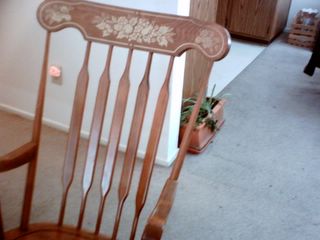
I dont know why certain things are there. why I started a garage sale and this chair given to me by my brother is an item there on www.royaartgallery.blogspot.com or www.online-garage-sale.blogspot.com . why some men in Iran have to wear a special underware,some like a cheese cloth? why a certain class used to wear it. I rememebr at dinner party this lady was describing how she made the cheese that we were eating and she said I used my husbands underware as my cheese cloth..iiikkhhh. well but the cheese tates good. Also why in Iran as asoon as there is an accident 100 people show up and just watch, JUST WATCH...a party starts right there,even if the accident happens in a very quiet street? why oh why? Why isnt the repeat of my favorite progam after 7:30 pm? when I am sure that I am home? where on internet I should go to watch the repeats? I am lost...why o why... we never thought that maybe our children were lactose intolerant and that was why they screamed and had diahrrea? why that never crossed my mind when I was feeding my son? so much milk we gave him...and we never thought of that. why oh why some words are considered as swearing and people get offeneded in some languages and not the oters like turtle egg is a swearing in chinese and dog egg is a swearing in Farsi? why oh why, now click on header....just for the heck of it!!what the hech is it? I want to see the repeat of programs after 7:3o or you can go to this site and feel very bad..
http://www.iranian.com/Satire/Cartoon/2006/February/kiss.html


hey my program is back, I like thousands of others are happy that our program is back. I only hope that people he was interviewing and liked Bazargan, wont be back, I REALLY hope so, atleast only once a month. I dont have patience for anything or anybody that has anything good about this regime, believe me we had enough of her. Welcome back,dear.


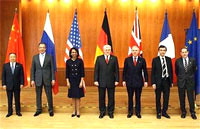
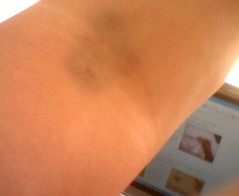


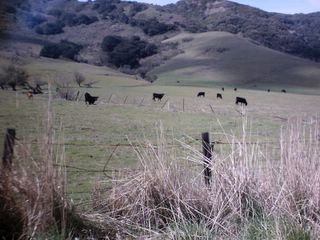

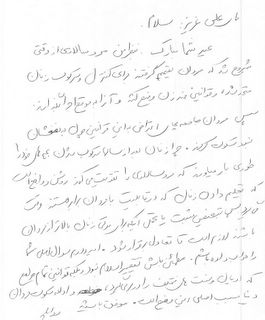


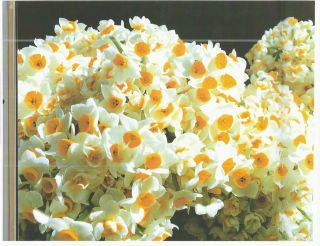

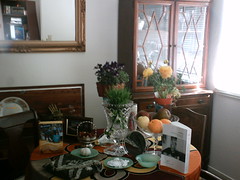

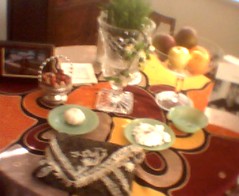
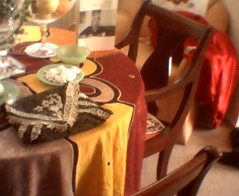
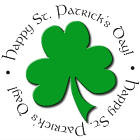



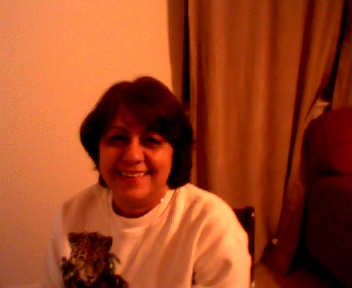
.gif)
